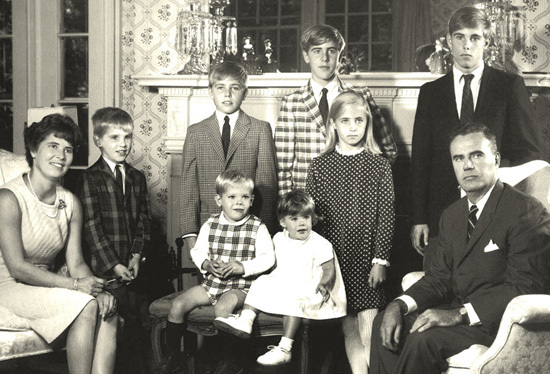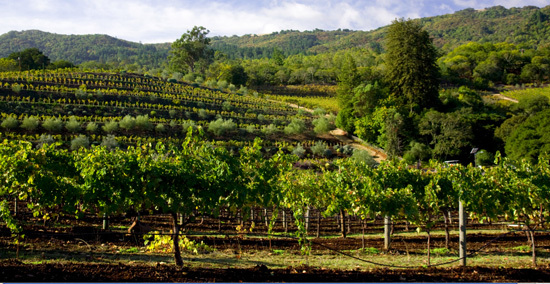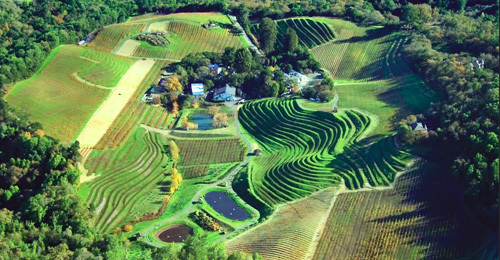
Co-authored by Lee Glenn
 Horns, moonlight ceremonies, revered cow manure, timing by the solstice... these were some of the mystical elements of biodynamic farming we were exploring and questioning at the Benziger family winery. Our experience couldn't be further from our expectations. We left with an appreciation for harnessing the tools of nature based on ancient practices.
Horns, moonlight ceremonies, revered cow manure, timing by the solstice... these were some of the mystical elements of biodynamic farming we were exploring and questioning at the Benziger family winery. Our experience couldn't be further from our expectations. We left with an appreciation for harnessing the tools of nature based on ancient practices.
This education and tour of the immaculate grounds came from Kathy and Mike Benziger, youngest and oldest of the seven Benziger siblings running the winery. Personable and infused with the magic that is the Benziger nature; Kathy's fervor and lucid explanation of biodynamics defined the tour through 85 acres, leading to the tasting room where proof was apparent.
The core of this approach... terroir... embodies wine with the distinct character of place and time.
...but first some history. After graduating from an east coast college, Mike backpacked across the country. Running out of money in Menlo Park, California, he worked for Beltromos Winery, learning the craft of winemaking and developing a dream of a family winery. Coincidentally, Father, Bruno, "Bruno in every sense of the word," an east coast liquor importer, was looking for an agrarian retirement plan. Mike persuaded him to come west and consider a winery. Looking for sites was uninspiring until they saw the Glen Ellen property, in a secluded, protected valley. They knew they were home. Bruno uprooted the entire family to an old country home on the property.
Initially, the property produced well, but ultimately its unique setting and market forces changed its attitude. The health of the soil was declining. The vines were "straight jacketed" by a mono-crop approach supported by artificial amendments. By 1995, consolidations in the wine industry saw family vineyards purchased by large conglomerates, driving prices down. The Benzigers needed a different approach to revitalize their vineyard and to compete on a quality basis. Beyond being varietally correct, they had to capture the unique characteristics of the vineyard through distinct farming practices.
Excited by the lore of biodynamic farming, Mike channeled the beliefs of Rudolph Steiner to rework their approach. Soil inputs were replaced by natural inputs; insects, plants, animals. "We chose to farm the property as a whole, not the vineyard," Kathy explains. "Our goal was to use life to create more life."
Pausing in the story, Kathy stopped for our first tasting, sheltered in one of four herb and vegetable gardens. We cleansed our palate by rubbing a lemon leaf on the back of our hands and smelling. We had no idea how aromatic a lemon leaf could be as it awoke our taste buds. The first tasting: a crisp Sauvignon Blanc. Joining us, Mike pointed to the forest in the hills surrounding the property, a living example of bio-diversity.
The biodynamic approach: "Plant a garden, buy a cow," says a smiling Mike.
"Read the rhythms of nature...bio means life, dynamic means rhythms." Mike adds as we walk through one of several carefully tended insectory/flower gardens, blooming with plants selected to attract beneficial insects and contributors to the natural cycle. "We had to bring nature in after we realized conventional farming pushed nature out."
The Benzigers embarked on a holy mission to restore the site's biological expression using naturalistic practices. Five years of transition were required to "...free the vines from the chemicals."
This was a plan of rediscovery, a return to historical agricultural methods of a pre-industrial age, culminating in biodynamic certification by Demeter. Livestock is a part of this equation, as are insectaries, bug breaks, wildlife highways, gardens and owl houses. A multiple-ecosystem reclamation program of ponds and wetlands cleanses irrigation water, a "natural liver" for the property. Areas of repair between the grape rows use olive, sage, crimson clover, purple vetch, rosemary and lavender to heal the soil. The livestock roam the vineyards, their tracks pushing diseased material into the soil where it's decomposed by bacteria. Cow manure is also used for high-octane compost... but more of that later.
"Create a healthy environment above ground and below ground, let the vine fend for itself," is Kathy's explanation. "Natural rhythms are captured in the grapes, and expressed through the medium of our wines," the essence of terroir.
...and the cow horn stuff. Actually, this is just a way to produce a powerful amendment for the vine's root system. The Benzigers make this a celebratory ritual, gathering family and staff under the fall equinox moon to pack the horn with fresh manure and bury it. It ferments underground for the right amount of time, marked by the spring equinox. It's unearthed and processed into a "compost tea." The mixture is applied at "root flush," after harvest but before the vine goes dormant when 90 percent of root development occurs. The quantity, one horn per acre...a mythological coincidence?...probably not. The practice...voodoo? witchcraft?...or naturalistic ways to ensure the right quantity of vital nutrients are returned to the soil? You decide.
Benziger's offerings are expanding as they purchase from grape growers trained in biodynamic practices. The family assists by helping growers select appropriate locations, advising on practices and providing handcrafted compost and home brewed herbal tinctures, gratis.
We ended in the tasting room with Vice President of Winemaking, Jeff McBride, who we had met at a wine pairing dinner with Mad Chef Jimmy Schmidt featured in one of our recent stories. As per Jeff, it's hard for a winemaker to hold back in order to feature the characteristics of the vineyard. "Wine is made in the vineyard, not in the winery," he says, explaining the distinction between wine growers and wine makers. "Our goal is not to taste the wine making."
At Benziger, the interpretation of air, earth and water is bottled in their wines. "Letting the genie out of the bottle" captures nature's rhythms expressed in this magical valley.
Rubbing the lamp,
Julie Brothers
Lee Glenn


